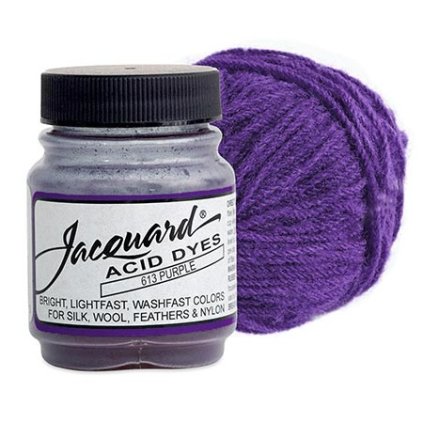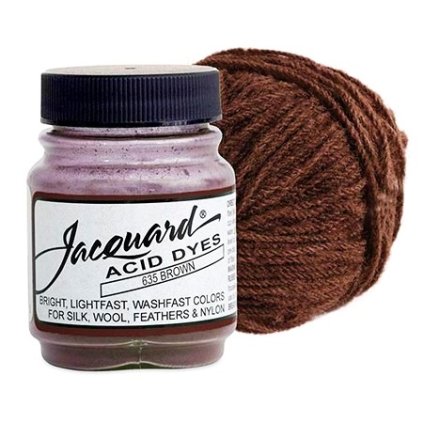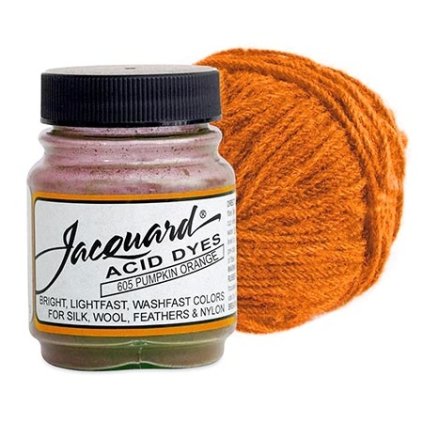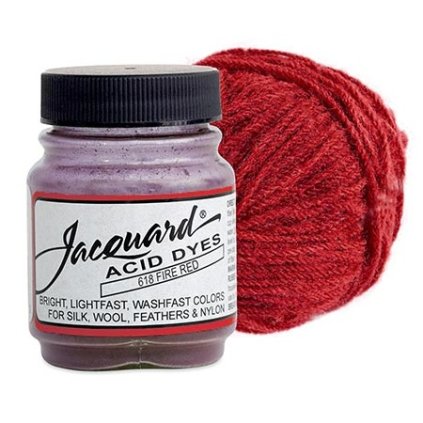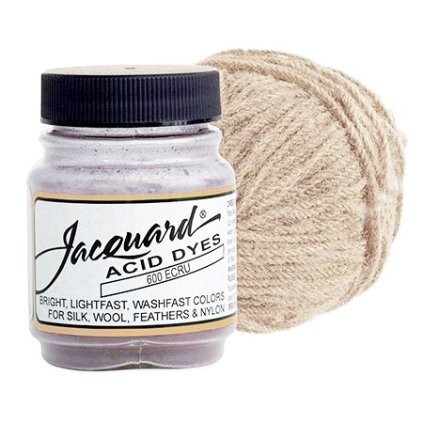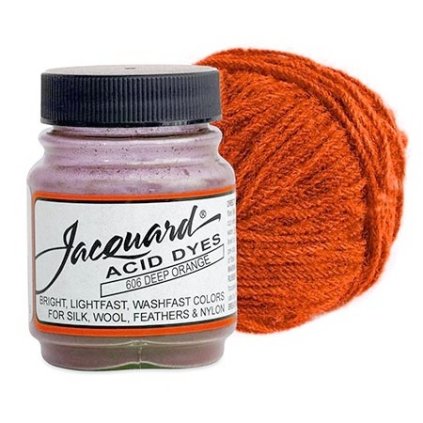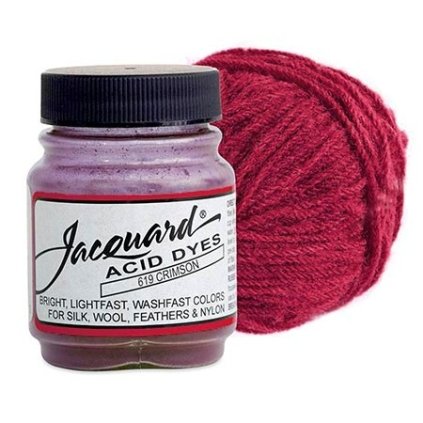Jacquard Acid Dye for wool and silk shade 614 Violet
Code: JACQUARD-AD-614Related products
Product detailed description
The variables in dyeing are temperature, dye concentration, time and amount of fabric. The washing machine method is the easiest way to dye fabric a solid color. However, if you are concerned with achieving the most accurate and reproducible results, or getting the darkest colors, we recommend using the stove top method. Use the instructions as a guideline. Acid dyes are quite forgiving and amenable to variations in procedure. The more you experiment, the more you will discover!
STOVE TOP METHOD: Best for wool.
1. Fill a stainless steel or enamel pot with just enough hot or warm water (cool for wool) for the fabric to swim freely. Turn the heat to medium.
2. Add the dye powder to the pot and stir until dissolved. Use the appropriate amount of dye for the desired shade (see chart below).
3. Thoroughly wet fabric with warm water and add to dye bath.
4. Gradually raise the temperature to 85˚- 90˚ C, just below boiling. Stir frequently.
5. Add a quarter cup of vinegar per pound of fabric. Another option is to add Citric Acid (1 tablespoon per 1/2kg of fabric). Try not to pour directly onto the fabric.
6. Maintain temperature and gently stir frequently for half an hour. Wash in Synthrapol® or mild detergent and warm water
NOTE: If you are dyeing wool, a gradual heating and gradual cooling of the dye bath is important so as not to shock and felt the wool.
In case you want to dye and use multiple colors at once, put the wool in the bath first, heat and gradually inject the powder into the areas where you want to dye.
You can also dye in the microwave if you want the colour combination to be exactly where you want it. It's very easy, soak the yarn as in the first example, but add the citric acid/vinegar already in the bath. Wring out and spread out on stretch film, mix the colours in a little water and acid and brush or carefully pour the colours where you want them. Always lift the fibres so that the paint really gets everywhere. When you feel you're done, roll the yarn into a stretch (like a roll, I guess :) being careful not to let the colours you don't want to come together touch each other. Roll up the "roll" some more and put it on a plate, tray etc and pop it in the microwave on the highest setting 700-900W, heat for less than a minute at first, then take it out and check, be careful, it's hot. Crumple a little, turn if necessary, don't poke with a fork :) Reheat for another minute and check again and then a third time. Pull out, let the wrapped ones cool completely and then knead as in the first case. The yarn should let almost no colour through, very little at first on the first swish.
1. Fill a stainless steel or enamel pot with just enough hot or warm water (cool for wool) for the fabric to swim freely. Turn the heat to medium.
2. Add the dye powder to the pot and stir until dissolved. Use the appropriate amount of dye for the desired shade (see chart below).
3. Thoroughly wet fabric with warm water and add to dye bath.
4. Gradually raise the temperature to 85˚- 90˚ C, just below boiling. Stir frequently.
5. Add a quarter cup of vinegar per pound of fabric. Another option is to add Citric Acid (1 tablespoon per 1/2kg of fabric). Try not to pour directly onto the fabric.
6. Maintain temperature and gently stir frequently for half an hour. Wash in Synthrapol® or mild detergent and warm water
NOTE: If you are dyeing wool, a gradual heating and gradual cooling of the dye bath is important so as not to shock and felt the wool.
In case you want to dye and use multiple colors at once, put the wool in the bath first, heat and gradually inject the powder into the areas where you want to dye.
You can also dye in the microwave if you want the colour combination to be exactly where you want it. It's very easy, soak the yarn as in the first example, but add the citric acid/vinegar already in the bath. Wring out and spread out on stretch film, mix the colours in a little water and acid and brush or carefully pour the colours where you want them. Always lift the fibres so that the paint really gets everywhere. When you feel you're done, roll the yarn into a stretch (like a roll, I guess :) being careful not to let the colours you don't want to come together touch each other. Roll up the "roll" some more and put it on a plate, tray etc and pop it in the microwave on the highest setting 700-900W, heat for less than a minute at first, then take it out and check, be careful, it's hot. Crumple a little, turn if necessary, don't poke with a fork :) Reheat for another minute and check again and then a third time. Pull out, let the wrapped ones cool completely and then knead as in the first case. The yarn should let almost no colour through, very little at first on the first swish.
WASHING MACHINE METHOD: Not for wool. (Wool may felt in a washing machine—use the stove top method instead.)
1. Dissolve the dye in approximately ½ to 1 cup hot water.
2. Pour the dissolved dye and 1 to 3 cups of white vinegar (depending on volume of water) into the bottom of the washing machine tub. You may also use Citric Acid, and add 1 tablespoon per 1/2kg of fabric. IMPORTANT: If your machine has a pre-wash flush, add dye and vinegar between the flush and wash cycles to prevent the dye from being flushed from the machine.
3. Add pre-wetted fabric.
4. Set your machine for the hottest possible water temperature and longest possible wash cycle. If you are able to extend the wash cycle, do so. The longer you are able to allow the fabric to remain in the wash/dye cycle the darker the color and the better the fixation.
5. When the machine has completed the wash cycle, allow it to complete the balance of the wash/rinse/spin cycle.
6. Wash the garment with a mild detergent in cold water and dry.
NOTE: We recommend a thorough cleaning of your washer after you have used it to dye fabric. Most front loading washers collect residual water in the front door gasket and will also hold water in the exterior tub. Wipe down the door gasket carefully and run a short cycle with your normal detergent after completing dye process. (You may want to refer to your Washing Machine Users Manual for cleaning instructions.)
1. Dissolve the dye in approximately ½ to 1 cup hot water.
2. Pour the dissolved dye and 1 to 3 cups of white vinegar (depending on volume of water) into the bottom of the washing machine tub. You may also use Citric Acid, and add 1 tablespoon per 1/2kg of fabric. IMPORTANT: If your machine has a pre-wash flush, add dye and vinegar between the flush and wash cycles to prevent the dye from being flushed from the machine.
3. Add pre-wetted fabric.
4. Set your machine for the hottest possible water temperature and longest possible wash cycle. If you are able to extend the wash cycle, do so. The longer you are able to allow the fabric to remain in the wash/dye cycle the darker the color and the better the fixation.
5. When the machine has completed the wash cycle, allow it to complete the balance of the wash/rinse/spin cycle.
6. Wash the garment with a mild detergent in cold water and dry.
NOTE: We recommend a thorough cleaning of your washer after you have used it to dye fabric. Most front loading washers collect residual water in the front door gasket and will also hold water in the exterior tub. Wipe down the door gasket carefully and run a short cycle with your normal detergent after completing dye process. (You may want to refer to your Washing Machine Users Manual for cleaning instructions.)
DYE QUANTITIES - Washing Machine Method:
Here is the general dye quantities chart to give you an idea of where to start. The quantities listed are for the deepest color saturation. For pastels and lighter colors, use less dye. Amounts of dye given per 1/2 kg of fabric. One bottle is about 14g of powder. (Stove top method will require less dye.)
Here is the general dye quantities chart to give you an idea of where to start. The quantities listed are for the deepest color saturation. For pastels and lighter colors, use less dye. Amounts of dye given per 1/2 kg of fabric. One bottle is about 14g of powder. (Stove top method will require less dye.)
| 7g-14g | 14g-42,5g | 42,5g až 57g | až 85g | |
|---|---|---|---|---|
| 600 | 604 | 606 | 622 | 618 |
| 601 | 610 | 609 | 623 | 632 |
| 602 | 620 | 611 | 624 | 639 |
| 603 | 627 | 612 | 625 | 636 |
| 605 | 628 | 613 | 629 | 635 |
| 607 | 633 | 614 | 630 | |
| 608 | 634 | 615 | 631 | |
| 636 | 616 | 621 | 637 | |
| 638 | 617 | |||
The paint is not toxic. Try to avoid inhaling dust from the paint. Avoid contact with eyes. May cause eye or skin irritation. Children may only use paint under adult supervision and preferably after mixing with water.
SOME BOTTLES STILL HAVE A PAPER OVERLAY UNDER THE CAP FROM THE FACTORY, THOSE WITH NEWER CAPS DO NOT HAVE AN OVERLAY!!! ALL COLOURS ARE ORIGINAL FROM THE MANUFACTURER.
SOME BOTTLES STILL HAVE A PAPER OVERLAY UNDER THE CAP FROM THE FACTORY, THOSE WITH NEWER CAPS DO NOT HAVE AN OVERLAY!!! ALL COLOURS ARE ORIGINAL FROM THE MANUFACTURER.
Be the first who will post an article to this item!
Add a rating
Be the first who will post an article to this item!
Koncentrovaná prášková barva Jacquard v provedení Acid Dyes - v kombinaci s kyselinou citrónovou nebo octem je vhodná pro barvení živočišných vláken jako vlna, hedvábí, alpaka nebo kašmír. V provedení Procion MX spolu s krystalickou sodou obarví rostlinná vlákna jako je bavlna a len a lze ji použít na barvení macramé.
| Manufacturing company : | Rupert, Gibbon & Spider, Inc. Manufacturers of Jacquard Products |
|---|---|
| Address : | P.O. Box 425, Healdsburg, CA 95448, USA |
| E-mail : | sales@jacquardproducts.com |
| EU representative of the manufacturer : | Pavel Sršeň |
| Address of the EU representative : | Kolovraty, Do Hlinek 742/12, 10300, Praha |
| Email of the EU representative : | infosilktrade@gmail.com |











